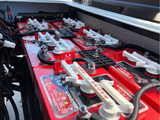How do I charge my battery and is it dangerous?
Question:
How do I charge my battery and is it dangerous?
Answer:
Always use extreme caution when charging a battery. All lead acid batteries contain sulfuric acid which can cause severe burns and can generate explosive gases. Even a maintenance free battery has vents to relieve the internal gases that build up inside the battery. Even though they look like sealed units, acid can still escape should the battery be tipped over or even over charged. The following tips from the Battery Council International (BCI) can be used as a general guide.
- Always charge a battery in a well ventilated area. Do not smoke or have an open flame near your charging area. Remember, all batteries produce hydrogen gases that can explode.
- Wear protective clothing, goggles and gloves when connecting a battery for charge.
- Remove the vent cap just slightly. Some of the vent caps now on the market today, require no removal of the cap.
- Cover the vent cap area with a wet cloth to prevent sparks from igniting escaping gases.
- On a low maintenance battery, check the water level in each cell. The water level should be just covering the top of the plates (about a 1/4" above the plates). If not, use distilled water to cover the plates. Never use tap water because minerals in the water will harm the plates. Always use water, never add battery acid (electrolyte) to cover the plates.
- Be sure to read and understand the instructions of your battery charger before you operate it. Should your charger be a multi-voltage charger, be sure to have it at the proper settings before operation.
- When connecting your charger leads to your battery, be sure the charger is off, the leads are connected to the proper terminals, and the settings on the charger are set to the proper rating. The charging rate for a specific battery is determined by the battery’s reserve capacity rating (RC).
Charging Rate
| RC (min) | Slow Charge | Fast Charge |
| 80 | 10 hrs – 5 amps | 2.5hrs – 20 amps |
| 80 – 125 | 15 hrs – 5 amps | 4.0 hrs– 20 amps |
| 125 – 170 | 20 hrs – 5 amps | 5.0 hrs – 20 amps |
During the charging process, should the battery case become hot to the touch, or should the liquid start to bubble out the vent caps, remove the battery from the charger and check the battery with a hydrometor.
Jun 21st 2010
Recent Posts
-
Powerstride’s Proper Battery Care Tip # 1
New batteries should be given a full charge before useThis is a very “common sense” tip! To ge …Apr 12th 2024 -
Aerial Lift Battery Basics
Aerial Lift Battery BasicsOne of the most important tools you have on your job site might be your ae …Feb 27th 2024 -
Golf Cart Battery Basics (UPDATED FOR 2024)
Golf cart batteries are vital to how well a golf cart runs. The batteries can affect speed, accele …Feb 15th 2024



